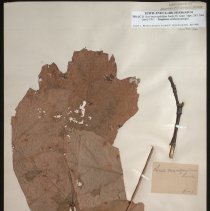Object Record
Images

Metadata
Catalog Number |
PH-LC 3 |
Object Name |
Specimen |
Title |
Acer macrophyllum |
Other Name |
Big-leaf Maple |
Collector |
Meriwether Lewis & William Clark |
Date |
1806 |
Description |
Pursh gives an expanded description and includes floral features taken from the inflorescences now preserved on the lectotype, a Lambert sheet. The type is dated 10 Apr 1806, and on 11 Apr Clark reports "the large leafed ash is in blume" (Moulton, 1991: 110). At this time the expedition was camped at the Cascades of the Columbia in Hood River Co., Oregon. The tree was well-known to Lewis as on 10 Feb 1806 he describes the species in some detail, considering it "a tree common to the Columbia river below the entrance of cataract river" (Moulton, 1990: 294). Both Lewis and Clark frequently referred to this species as an ash (Moulton, 1991: 14). (The Lewis & Clark Herbarium Digital Imagery Study Set, ANSP, 2002) On deposit at the Academy of Natural Sciences, Philadelphia |
Label |
Starting in 1803, Merriwether Lewis (APS 1803) and William Clark embarked on a 3 year expedition along the Missouri and Columbia rivers to the Pacific Coast. They collected hundreds of plant specimens to carry back to the East Coast. They pressed these plants, attached them to sheets of paper and wrapped them in oilskin to survive the long journey intact. While the expedition was camping in Hood River County, Oregon, along the banks of the Columbia River, Lewis and Clark made note of the bigleaf maple tree Acer macrophyllum native to this region, both referring to it however, as a species of ash. The big leaf maple has traditionally been used by indigenous communities along the northwestern coast of the United States for woodworking, basketry, weaving, in medicine, and to produce maple syrup. |
Credit line |
American Philosophical Society. Gift of Thomas Jefferson, 1805 - 1806. |
Search Terms |
19th century botany Clark herbarium Lewis nineteenth century plant specimen |
Collection |
The Lewis & Clark Herbarium |
